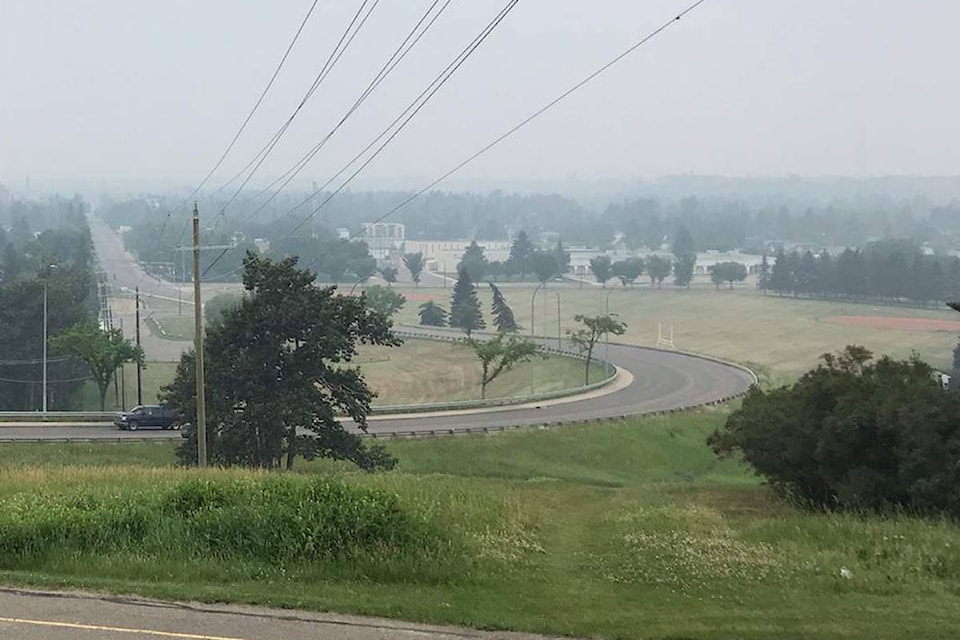Red Deer has had the second warmest summer on record so far.
In the 107 years of available records, only 1961 proved a hotter summer, said Environment and Climate Change meteorologist Kyle Fougere.
The mean temperature for the summer has been 16.8 C, a full two degrees warmer than the typical 14.8 C. The mean is reached by combining all of the daytime temperatures and averaging them and then averaging those numbers for the summer.
June came in as the second hottest June on record — again 1961 proved hotter. July was the sixth warmest on record and August was the 27th.
While it was a dry summer, it ranks only as the 41st driest, largely because of the rain that finally came in August. That month 98 mm of rain fell, compared with the 72 mm that is typical for the month.
“Thank goodness. It was about time we had a wet month. It was much, much needed obviously,” said Fougere.
The heat and the smoke were probably the biggest weather conversation starters for many central Albertans this year. Heat warnings and special air quality statements almost became routine as the summer wore on.
At the end of June and into early July, Alberta baked. There were at least 212 daily temperature records set across the province — including at least one in Red Deer — from June 25 to July 2.
The high of 34.8 C recorded in Red Deer on June 30 beat the previous record of 30.6 C set in 1944.
The heat wave was felt throughout the province. In August, Edmonton set a record with 17 days above 30 C, eclipsing the previous record of 14 days set in 1961.
Fougere said meteorologists and climatologists are busy compiling all of the statistics and will present an overview later this month.
“There are just thousands and thousands of data points we have to go through.”
The cause of the lengthy blast of heat was an unusually strong ridge of high pressure over Western Canada, explained in early July.
“You basically had low-pressure systems on either side which created what we call a blocking pattern. That blocking pattern is what made it sit over the western parts of Canada for a week on end and the temperatures just really built.
“It was both the magnitude of the ridge and this blocking pattern that led to this extreme heat.”
Amazingly, daytime temperature peaks could have been higher except for the blanket of smoke from wildfires far to the southwest of central Alberta.
“It was a hot summer, but, absolutely, it could have been hotter if not for the forest fire smoke,” he said. “A lot of times it looked like we were going to have very high temperatures and we were knocking off several degrees from what we expected from the daytime highs because of the smoke.
“The sun just wasn’t able to infiltrate that smoke and make it down to the surface.”
So, if not for the smoke it would easily have been the hottest summer on record right?
Not so fast, explains Fougere. While the smoke may have checked daytime highs, it also trapped warmth leading to balmier-than-usual evenings. Since the records are built on averages of highs and lows, 1961 may still have been the hottest all things considered.
“Not only does (the smoke) block our incoming radiation, but it blocks our outgoing solar radiation, keeping our mornings warmer.”
Another interesting aspect of the past summer was the lack of thunderstorms, despite conditions, which seemed to be perfect for creating the lightning lightworks and rain deluges or hail storms that are a common summer feature.
“There were absolutely days where the conditions were there for thunderstorm development to be fairly widespread. But the thunderstorms just didn’t form, or only a few formed, because of the smoke.”
“It prevented that heat and the lift from the surface we typically get from that daytime heating.”
The ridge of high pressure, which created the heat wave, also acted to reduce the thunderstorm threat.
“I know there were days when we were looking and all the ingredients were there for severe thunderstorms. And on those days, typically you would have seen widespread severe weather and we had almost nothing this year. There were several days like that.”
The lack of thunderstorms and the rain they bring was a big reason it was such a dry summer.
